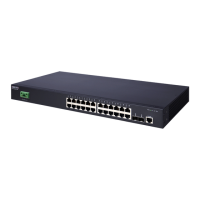Chapter 8
| Authentication Commands
Secure Shell
– 248 –
Public Key Authentication – When an SSH client attempts to contact the switch,
the SSH server uses the host key pair to negotiate a session key and encryption
method. Only clients that have a private key corresponding to the public keys
stored on the switch can access it. The following exchanges take place during
this process:
Authenticating SSH v1.5 Clients
a. The client sends its RSA public key to the switch.
b. The switch compares the client's public key to those stored in
memory.
c. If a match is found, the switch uses its secret key to generate a
random 256-bit string as a challenge, encrypts this string with the
user’s public key, and sends it to the client.
d. The client uses its private key to decrypt the challenge string,
computes the MD5 checksum, and sends the checksum back to the
switch.
e. The switch compares the checksum sent from the client against that
computed for the original string it sent. If the two checksums match,
this means that the client's private key corresponds to an authorized
public key, and the client is authenticated.
Authenticating SSH v2 Clients
a. The client first queries the switch to determine if DSA public key
authentication using a preferred algorithm is acceptable.
b. If the specified algorithm is supported by the switch, it notifies the
client to proceed with the authentication process. Otherwise, it
rejects the request.
c. The client sends a signature generated using the private key to the
switch.
d. When the server receives this message, it checks whether the
supplied key is acceptable for authentication, and if so, it then checks
whether the signature is correct. If both checks succeed, the client is
authenticated.
Note:
The SSH server supports up to eight client sessions. The maximum number
of client sessions includes both current Telnet sessions and SSH sessions.
Note:
The SSH server can be accessed using any configured IPv4 or IPv6 interface
address on the switch.

